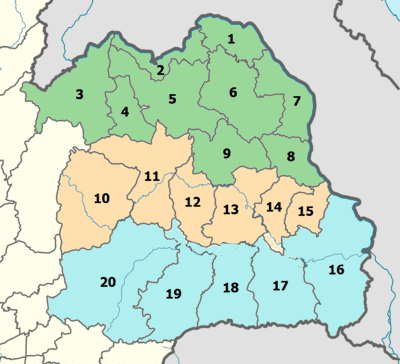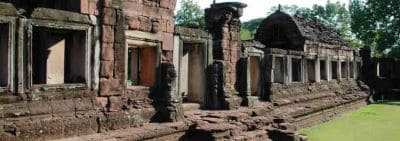Home › Information Diving › Thailand Travel Tips › Northeast
North East Thailand Isan (Isaan)
No matter whether you call it Isan, Isaan, or plain old Thailand north east, it's one of the remotest areas anywhere in the kingdom - but no less scenic or exciting!
The historic ruins and cultural traditions in the north east of Thailand epitomise how life used to be many centuries ago in the plateaus of the northeastern highlands.
North-Eastern Provinces Steeped in History
By and large, Isan is not an affluent area for the masses and farming is the main source of income.
Excluding the big cities, the entire region consists of small farms, rural villages, and large families - often living under a single roof.
Nonetheless, Isan is gradually gaining popularity as a tourist hub, and it has become a getaway haven for expats leaving hectic cities behind, especially Bangkok and Pattaya.
Many expats end up living in Isan at the behest of their Thai girlfriends and wives who they have met in other parts of Thailand.
As a consequence of that, they will be settling in a region where history is on show everywhere, with the exception of the farm lands.
The old temples are almost exclusively Khmer (aka Cambodian) in origin. In some ways, the neglected condition of so many ancestral ruins helps to convey a sense of major changes over the last 5,000 years or so in this particular area.
Here's the thing:
North eastern Thailand was once more allied to Cambodia than to Thailand. This aspect of its history is still evident today through the Khmer ruins and temples that remain almost intact throughout the region.
Geographically, the north east of Thailand is the largest area in the kingdom (by land mass). Most of the flat plains provide fertile land for small family farms to produce rice and grow traditional fruits, such as papayas, mangoes, or persimmon.
Festivals in Isan
Each year, Thai people and foreigners in Isan celebrate several unusual festivals and unique events that take place in specific months.
Boats, elephants, rockets, silk, candles and the other Thai festivals such as Songkran and Loi Krathong, make Isan an exciting and educational place to visit - or live!
Check out a section that contains a list of Isan festivals with details about the festivities that only happen in north eastern regions of Thailand.
20 Provinces of Northeastern Thailand
There are no beaches and islands in the north east of Thailand. So, when travelling around Isan you could be forgiven for thinking that not too many people live here. That would be wrong!
In fact, almost one third of the total population of Thailand live in the area known as Isan - around twenty two million.
Thai farmers use this large mass of agricultural land to grow produce, especially Thai jasmine rice, sweet corn, and sugar cane.
 But, the four most important cities for commerce and industry are:
But, the four most important cities for commerce and industry are:
- Khon Kaen (KK)
- Khorat (Nakhon Ratchasima)
- Ubon Ratchathani
- Udon Thani
Tip: The rainy season runs from May to October. But, Isan is hot - sometimes very hot - and for most of the year!
1. Bueng Kan
A range of tourist attractions draw regular visitors to Bueng Kan province, especially for scenic mountain views and refreshing waterfalls.
Bueng Kan is Thailand's newest province and now the most northerly province in Isan. It shares its borders with the Mekong River and the Bolikhamsai province of Laos.
As it becomes more established, tourists will learn more about its heritage, culture, and historical places of interest.
2. Nong Khai
The Mekong River is the longest river in Thailand, and around three hundred and twenty (320) kilometres of it runs through the province of Nong Khai.
Apart from being a major tourist destination, Nong Khai city is also a launching point for journeys around northeastern Thailand (greater Isan) or for entering Laos.
Some of the major attractions for foreigners heading to Nong Khai province include stunning countryside, religious temples, and the traditional culture bestowed to the north east of Thailand.
3. Loei
4. Nong Bua Lamphu
5. Udon Thani
6. Sakon Nakhon
7. Nakhon Phanom
8. Mukdahan
Its closeness to the Laos border is the main reason why Mukdahan province is the ideal access point from both countries, usually by the bridge that straddles the Khong River.
Nicknamed the pearl on the bank of the Mekong, the population of the province reflects the eight different ethnic minorities that live there and the natural beauty of the countryside.
9. Kalasin
10. Chaiyaphum
11. Khon Kaen
It's fair to call Khon Kaen province a large commercial and political hub in Northeastern Thailand. Yet, this region in the heart of Isan is still growing and attracting more visitors every year.
As a consequence, the nomination of Khon Kaen as the export center for trade throughout the Indo-China Region is a worthy one. Hence, the consulates of Vietnam and Laos process their VISA applications in the city center.
Not only is this busy province renowned for the production of high-quality silk, it's also home to Khon Kaen University, the biggest in the northeast of Thailand.
12. Maha Sarakham
13. Roi Et
If you're interested in Buddha images and spectacular Isan festivals (including the rocket festival), a visit to Roi Et province would not be misplaced.
For the most part, this north eastern Thailand province is famous for jasmine rice planting, wickerwork, and traditional textiles.
14. Yasothon
15. Amnat Charoen
16. Ubon Ratchathani
17. Sisaket
18. Surin
19. Buriram
Buri Ram is one of the most important and sought after provinces in Isan for Thai nationals and for foreign tourists. Geographically, it has borders with:
 Khen province and Mahasarakham province to the North.
Khen province and Mahasarakham province to the North.- Sa Kaeo province to the South.
- Surin province to the East.
- Nakhon Ratchasima province to the West.
It's also true to say that the province of Buriram shares a section of its southern border with the north of Cambodia.
Buri Ram is one of the highest provinces in the north east of Thailand. But, the surrounding plateaus and flat plain areas have an important role to play in the rice farming industry.